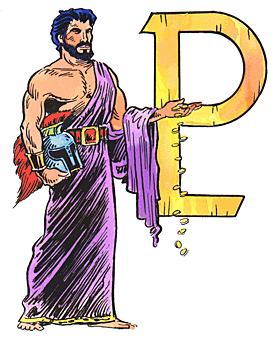Pluto, Roman god; Hades, Greek god
Pluto, Roman god of wealth, ruled the dark underworld of myth
(ninth planet from the sun).

The darkly lit outermost world bears the name of Pluto and the first two letters, “Pl”, of Pluto is the planet’s symbol.


Astrological Sign
- A euphemistic name for Hades, the Romans borrowed the title from the Greeks.
- Pluto was the god of the lower world in Roman mythology and his name meant riches or wealth from Greek ploutos and related words; such as, plutocracy (rule or government by the wealthy) come from the Greek and is based on the belief that precious metals and crops came from his underground realm.
A few scientific facts about Pluto:
- Allowing for the influence of Neptune, the motion of Uranus still lagged a little.
- At the beginning of the 20th century, American astronomer Percival Lowell, among others, made calculations of where a ninth planet (Planet X) might be.
- The search for this planet was inspired by the fact that the discovery of the eighth planet, Neptune, did not completely account for the irregularities in the orbit of the seventh planet, Uranus.
- Observations of Neptune itself showed it did not orbit as expected.
- Between 1905 and his death in 1916, Lowell and his colleagues made telescopic sweeps of the area where the planet was thought to be, but they were unable to find it.
- Over a decade later, Lowell’s successors at the Lowell Observatory in Flagstaff, Arizona, installed a new telescope and appointed young astronomer Clyde W. Tombaugh to continue the search.
- He painstakingly photographed the sky and compared pictures taken several days apart, looking for moving objects.
- On February 18, 1930, he found something (Planet X?) that had moved against the background stars, compared with the plates he had taken on January 21, 23, and 29.
- It was five degrees from where Lowell had predicted it might be.
- The announcement of the discovery was made on March 13, 1930.
- Since the ninth planet moves farthest from the light of the sun and farther into the darkness of the space between the stars, it was named Pluto (whose name happens to begin with the initials of Percival Lowell), after the Roman god of the underworld, lord of the dead, and giver of wealth.
- The naming of Pluto is a story by itself. Early suggestions of the name of the new planet were: Atlas, Zymal, Artemis, Perseus, Vulcan, Tantalus, Idana, Cronus. The New York Times suggested Minerva, reporters suggested Osiris, Bacchus, Apollo, Erebus. Lowell’s widow suggested Zeus, but later changed her mind to Constance.
- Many people suggested the planet be named Lowell. The staff of the Flagstaff observatory, where Pluto was discovered, suggested Cronus, Minerva, and Pluto.
- A few months later the planet was officially named Pluto which was originally suggested by Venetia Burney, an 11-year-old schoolgirl in Oxford, England.
- Some scientists believe there may be a planet beyond Pluto, since its gravitational pull is not considered big enough to account for all the deviations of Neptune; however, no proof of another planet has been provided.
- The search for Planet X continued but nothing has been found, nor is it likely that it ever will be.
- The discrepancies vanish if the mass of Neptune determined from the Voyager 2 encounter with Neptune is used; so, there is no evidence of a tenth planet.
- Pluto is tiny, even compared with Earth, which is five times larger and 500 times as massive.
- Pluto’s rocky core is covered with a thick layer of water ice, overlaid with a layer of ice mixed with frozen methane.
- When closest to the Sun, a thin atmosphere of methane and, probably, nitrogen boils off the surface.
- In sunlight, its surface appears pinkish, indicating the presence of carbon and there are white polar caps, probably made of frozen methane.
- In 1978, American astronomer Jim Christy found that Pluto had a satellite.
- The satellite, Charon, is over half Pluto’s diiameter and, at 12 204 miles (19 640 km) from it, twenty times closer than Earth’s moon is.
- Charon is named for the mythological figure who ferried the dead across the River Aceron into Hades (the underworld).
- Though officially named for the mythological figure, Charon’s discoverer was also naming it in honor of his wife, Charlene; thus, those in the know pronounce it with the first syllable sounding like ‘shard’ (SHAHR en).
- Charon is much like Pluto, but too small to retain methane, so its surface is pure ice.
- Pluto and Charon are pitted with craters.
- Both bodies are so small that it is thought they may be asteroids.
- Charon and Pluto are so close that tidal force has locked their spins and orbits.
- They spin in opposite directions and the same sides always face each other.
- Seen from Pluto’s surface, Charon hangs motionless in the sky, never rising nor setting.
 You may return to the page of planet images from here.
|